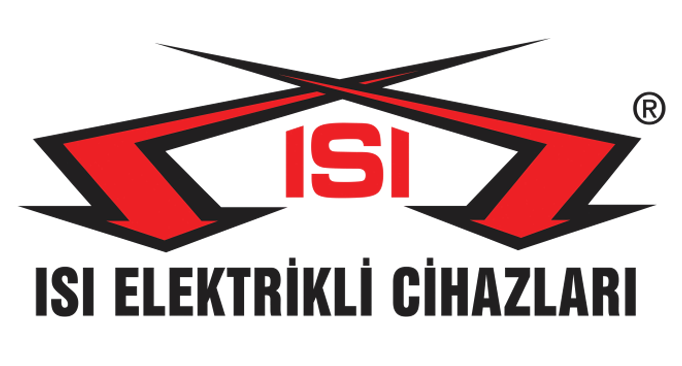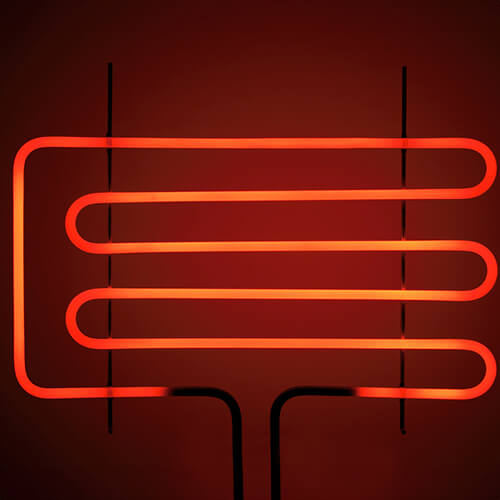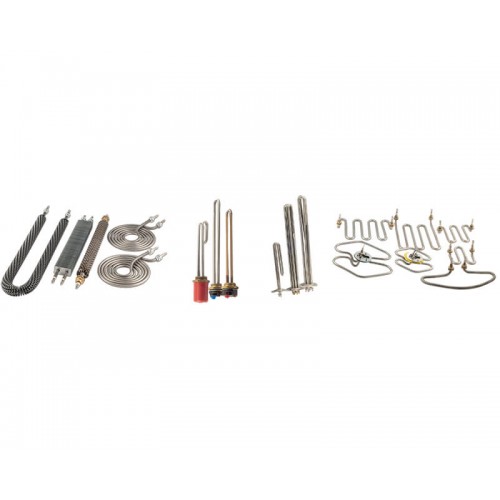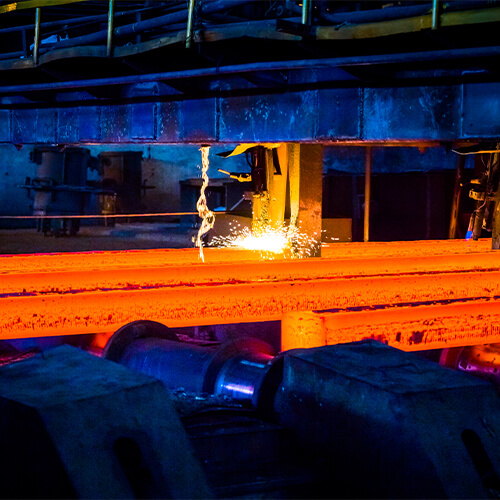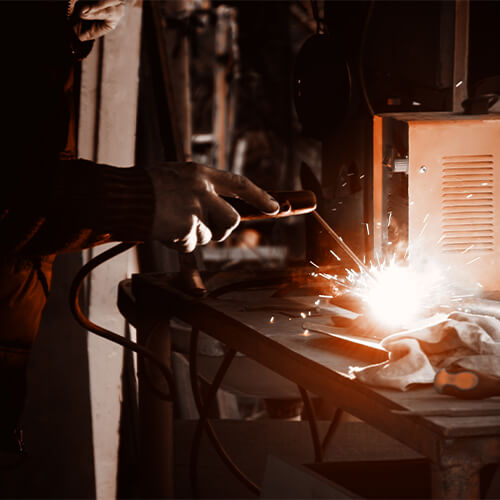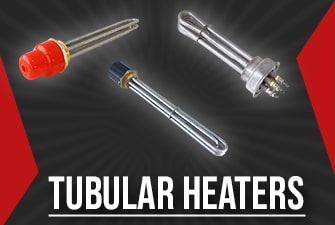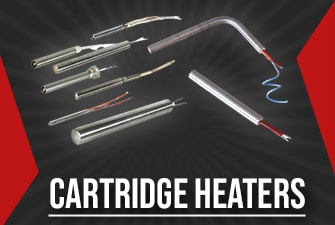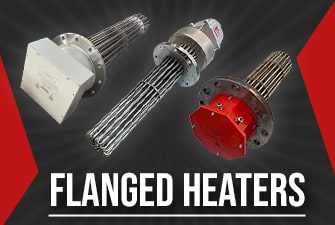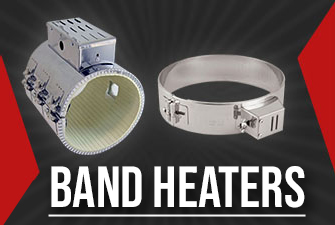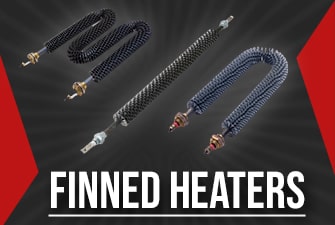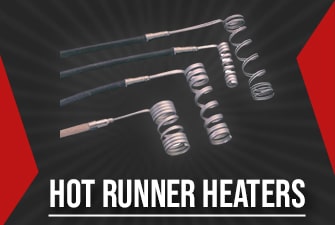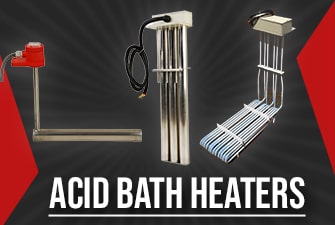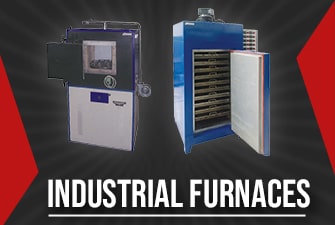Heaters
Heaters is derived from the Turkish word 'rezistans'. Resistance is an element that produces resistance to electric current, that is, it opposes electric current. Resistors that resist electric current cause an increase in the current (Amperes) value in the system and are elements that generate heat. In other words, we can think of resistors used as heat generators that convert electrical energy into heat energy. Resistors used as heat generators are frequently used in industry, manufacturing, and even household appliances. The areas of use of resistors used in many fields of industry can be listed as follows:In the plastic sector: clamp heaters, plate type heaters, pellet heaters, nozzle heaters, hot runner (spiral) heaters
In liquid, fluid, or gas heating: flanged heaters, headed type (three-phase) heaters, rod heaters, sleeve heaters are used.
In drying and ventilation processes: serpentine heaters, cassette type heaters, pipe type heaters are used.
The types of heaters in industrial furnaces vary according to the operating temperatures. Standard 304 Cr-Ni sheathed heaters are used around 250-300 °C, while incoloy800 series outer sheathed tube heaters are used between 300 °C and 600 °C, and incoloy825 series should be preferred above 600 °C. Instead of tube sheathed heaters, heaters made of spiral wound Cr-Al or Cr-Ni alloy helically wound bare furnace wires should be used.
In chemical processes, immersion type polypropylene-headed heaters are generally preferred. Immersion heaters also use many different outer sheaths depending on the chemical the heater will work in. Some of these are teflon sheathed heaters, titanium sheathed heaters, AISI316 stainless steel sheathed heaters, incoloy825 sheathed heaters, lead sheathed heaters.
Engineering knowledge and design are very important in the manufacturing and design of heaters. The long-lasting and process-appropriate selection of heaters directly affects the health and quality of your process. Heaters must be carefully selected and designed according to the surface loads of heaters according to the place of use, environment, and temperature value.
When manufacturing a heater, all details from the outer sheath to the insulation material to be used inside must be carefully selected. For example, completely different materials should be used between a heater that will work in water and a heater that will work in an oven. Materials used in heater manufacturing can be listed as follows: Magnesium oxide (MgO) with high electrical insulation and heat conduction coefficient, the resistor wire that performs the main heat production process by resisting electricity, the insertion or terminal outputs that allow energy supply, stainless outer sheath. All these materials should be selected according to the place of use.
In general, the heater is selected in the form of a spiral resistor wire in the center according to the desired wattage and the length of the heater. Terminals that will supply energy to the end parts are mounted in spiral form under appropriate conditions. Then, the outer stainless sheath is prepared in the form of a tube of the desired length, and with special filling machines, the heater wire is centered in the tube and magnesium oxide filling is filled around it. Magnesium oxide is in powder and fluid form when first filled. Then, the filled heater is passed through rolling machines for rolling process. In this process, magnesium oxide is transformed from powder to solid and compressed form, the resistor wire in the center is fixed, and the internal structure of the heater is made to conduct heat as quickly as possible. Then, after the rolled heaters are in the form of bars, they are subjected to annealing process for shaping, and annealing process is done for softening in order to shape the outer stainless sheath. The annealed heater is now ready to be shaped as desired. The shaped heater is welded to the appropriate assembly equipment or assembled to be suitable for use. Another important point to be paid attention to in heater production is that the leakage current and insulation resistance values of the produced product under high voltage should be at suitable levels. If these values are not at the appropriate level, heaters can cause problems in a very short time in the place of use. A heater produced in accordance with all standards will always satisfy its user.
Types of Heaters
- Tubular Heaters
- Flanged Heaters
- Exproof Heaters
- Water & Oil Heaters
- Oven Heaters
- Cartridge Heaters
- Serpentine Heaters
- Air Blower Heaters
- Plate Heaters
- Clamp Heaters
- Spiral Heaters
- Ceramic Heaters
- Nozzle Heaters
- Flexible Silicone Heaters
- Thermocouples
- Fan Heaters
- Manifold Heaters
- Acid Bath Heaters
- Quartz Infrared Heaters
- Divisible Cable Heaters
- Heating Bands
- Industrial Furnaces
- Drying Furnaces
- Annealing Furnaces
- Tempering Furnaces
- Tunnel Furnaces
- Atmosphere Controlled Brazing (Welding) Furnaces
- Vacuum Dehumidification Furnaces
- Smelting Furnaces
- Oven Manufacturing Products
- Sleeve Heaters
What is Heaters?
Heaters, also known as electrical resistance or heating elements. It is an electrical component that converts electrical energy into heat energy through resistance. Heaters are typically made of metal alloys, wires, or strips and are used in various electric heating systems. Heaters provide heating by converting electrical energy into heat when electrical current passes through them. With this feature, they are used in many industrial and household heating devices such as water heaters, ovens, stoves, water heaters, heating fans, and industrial furnaces. Heaters have a specific resistance value and power level. Heat is generated due to resistance as electric current passes through the heater. This heat can be used for various heating purposes depending on the design and material of the heater.
History of Heaters
The history of heaters is closely linked to the discovery of electricity and electronics. The first heaters were developed experimentally in the late 18th and early 19th centuries.18th Century:
- In 1745, Pieter van Musschenbroek discovered the first capacitor known as the Leyden jar. This discovery enabled the measurement of electrical current resistance.
- In 1785, Charles-Augustin de Coulomb discovered Coulomb's law, defining the relationship between electrical charges. This law contributed to further development of the concept of resistance.
- In 1826, Georg Ohm discovered Ohm's law, defining the relationship between voltage, current, and resistance in an electrical circuit. This law laid the theoretical foundation for heaters.
- In 1843, Samuel Hunter Christie invented the first wire-wound resistor. These resistors were made of resistant metals such as nichrome or platinum.
- In 1856, William Siemens invented the Siemens-type resistor. These resistors consisted of a nichrome wire wound inside a glass tube.
- In the early 20th century, carbon film resistors and metal film resistors were developed. These resistors replaced wire-wound resistors due to their smaller size and higher precision.
- In the mid-20th century, semiconductor resistors were developed. These resistors were advantageous over other types of resistors due to their higher resistance values and lower power consumption.
Our Position as Heaters in Our Industry
Isı Elektrik Rezistans Ltd., we are among the world leaders and investors in electric heating appliances, industrial furnaces, and industrial heaters.For over 60 years, we have been growing successfully in sectors where we are experts worldwide and maintaining a strong presence in local markets.
With our factories located in 2 different locations in Istanbul, we strive for superior customer satisfaction.
We are always by your side as your solution partner for your industrial heating needs.
How Do Heaters Work?
Heaters are electrical components that convert electrical energy into heat energy. The working principle involves the resistance of the heater and the generation of heat as electric current overcomes this resistance.Essentially, the electrical resistance within a heater impedes the free flow of electrons. As electrons move through the heater, they encounter resistance, resulting in an energy loss. This energy loss is converted into heat.The heat within the heater varies depending on the structure of the resistance material and the speed of current flow. The higher the resistance of the heater, the more resistance the electric current encounters, thus producing more heat.Heaters are typically made in the form of metal wires or film layers. Metal wires carry electric current while creating resistance and generating heat. Film heaters, on the other hand, are produced in thin film layers and mounted on surfaces. Heat is generated as the current passes through the film layers.In this way, heaters convert electrical energy into heat for various applications such as heating, cooking, industrial processes, and current control in electronic circuits.Materials Used in Heater Production
Various materials are used in heater production:- Nickel-Chromium Alloy: This alloy is the main component of heaters. Nickel-chromium alloy is resistant to high heat and can maintain resistance steadily.
- Stainless Steel: It is a commonly used body material in industrial heaters. Stainless steel is resistant to corrosion and long-lasting.
- Magnesium Oxide (MgO): Used for insulation. MgO is resistant to high temperatures and electrical insulation, thus ensuring the safe operation of the heater.
- Ceramic: It is a commonly preferred material in strip heaters. Ceramic is resistant to high temperatures and impacts, and it distributes heat evenly.
- Copper or Alloys: Used in connection points. It has high electrical conductivity and enhances the reliability of connections.
- Ceramic Coating: Used to protect the outer surface of the heater and prevent rust.
- Tungsten: It is resistant to high temperatures and is preferred in some high-heat applications.
- Insulation Materials: Used to insulate the internal parts of the heater. Materials such as fiberglass, ceramic, and quartz are used for this purpose.
- Coating and Protective Materials: Epoxy resins, silicone coatings, and ceramic paints are used to coat and protect the outer surface of the heater.
- Assembly and Connection Elements: Elements such as screws, clamps, and connection terminals necessary for the assembly and connection of the heater.
- Temperature Sensors: Some types of heaters contain integrated sensors for temperature detection and control.
- Insulation Tapes and Bands: Used to increase electrical insulation.
- Connection Wires and Cables: Wires and cables used to provide electrical connection.
These materials are important for the durability, performance, and safety of heaters. Manufacturers strive to select the most suitable materials to improve the quality and efficiency of their products.
Importance of Heaters in Industries
Heaters play a significant role in many industrial and commercial sectors. Here are some sectors where heaters are important and their roles:
- Food Industry: Heaters are used for temperature control in food processing and production facilities. They play a crucial role in cooking, heating, cooling, and drying processes.
- Automotive Industry: In the automotive sector, heaters are used for temperature control in vehicle heating systems, seat heating systems, and engine temperature control.
- Medical Industry: Medical devices and laboratory equipment often require temperature control. Heaters can be used for heating liquids in medical devices or sterilizing laboratory equipment.
- Chemical Industry: Temperature control is crucial for maintaining control over chemical reactions in the chemical industry. Heaters are used to control reaction temperatures.
- Plastic Industry: Temperature control is necessary for plastic production, where plastic materials need to be melted and shaped. Heaters are used to provide temperature in this process.
- Energy Sector: Heaters are used for temperature control in many devices and equipment in energy production and transmission.
- Electronic Industry: Heaters play an important role in electronic devices, especially in sensors and control systems that require heating and cooling. They are also used in soldering processes and circuit board production.
- Entertainment and Interactive Technology: Heaters are used for temperature control in entertainment industry equipment such as thermal cameras, music systems, and stage lighting.
- Construction and HVAC (Heating, Ventilation, and Air Conditioning): Heaters play an important role in building heating and cooling systems. They are used in heating and cooling devices, radiators, heating pipes, and air conditioning systems.
- Agriculture and Agricultural Technologies: In the agriculture sector, heaters are used in applications such as greenhouse heating systems and soil heating systems.
- Metal Industry: Heaters are used to provide high temperatures in metal melting and shaping processes. They are also widely used in the processing and shaping of alloys in the metallurgy industry.
- Maritime Industry: In the maritime sector, heaters are used in systems for hot water production, heating, cooling, and desalination of seawater.
- Renewable Energy Sector: Heaters are important for temperature control and heating components used in electricity generation in solar panels and wind turbines.
- Aviation Industry: Heaters are used for temperature control and heating systems in aircraft and spacecraft.
- Drinking Water and Wastewater Treatment Plants: Heaters are used for heating and processing water in treatment plants. Temperature control is necessary for disinfection and purification of drinking water in drinking water treatment plants.
- Electric and Electronic Production: Heaters are commonly used in the production and assembly of electrical devices, soldering processes, and circuit board production.
Types of Heaters Used in Various Sectors
There are several different types of heaters used in different industries and applications. Here are some of them:- Wire Heaters: Wire heaters are a simple and common type of heater typically used at high temperatures. Wire heaters can be in coil form and may include heating elements.
- Film Heaters: Film heaters are typically produced in thin film layers and mounted on surfaces. These heaters are used in many applications such as heating pads, thermal prints, and temperature sensors.
- Ceramic Heaters: Ceramic heaters are often preferred in industrial heating applications due to their high temperature tolerance and durability. Ceramic heaters are commonly used in ovens, stoves, and other high-temperature devices.
- Carbon Film Heaters: Carbon film heaters are frequently used in electronic devices due to their flexibility and low cost. They are commonly found in applications such as thermal prints and heating pads.
- Metal Film Heaters: Metal film heaters are used in precision electronic applications. They are preferred for their low tolerance and low temperature coefficient.
- Carbide Heaters: Carbide heaters are durable heaters used at very high temperatures. They are widely used in industrial applications such as metal melting and high-temperature processes.
- Quartz Heaters: Quartz heaters are used in industrial heating and drying applications due to their high temperature tolerance and fast response times.
- Cermet Heaters: Cermet heaters consist of a combination of ceramic and metal and provide high temperature resistance. They are used in applications requiring precise temperature control.
- Immersion Heaters: Immersion heaters are commonly used for heating liquids. They have a metal sheath that is immersed in the liquid, heating the liquid quickly.
- Infrared Heaters: Infrared heaters perform heating processes by emitting heat in electromagnetic wavelengths. These types of heaters are commonly used in industrial drying and baking applications.
- Enclosure Heaters: Enclosure heaters are available in a variety of materials and configurations. They are ideal for industrial heating applications requiring high power.
- Halogen Heaters: Halogen heaters are preferred for applications requiring rapid and intense heating. They have a short warm-up time and provide intense heat.
- Induction Heaters: Induction heaters produce heat through electromagnetic induction. They are used especially in industrial kitchen equipment, metal melting processes, and other high-power applications.
- Stainless Steel Heaters: Stainless steel heaters are designed to be resistant to corrosion, making them ideal for use in humid or aggressive environments such as the food processing, chemical, and maritime industries.
General Properties of Heaters
Heaters are essential components used in various industrial processes by converting electrical energy into heat. These components are typically defined by their resistance to electrical current, and this resistance affects the amount of heat generated. Below are the details of the fundamental properties of heaters:
- Resistance: Measured in Ohms (Ω), resistance indicates how much a conductor resists the flow of electrical current. The higher the resistance, the lower the current flow. This property is important for controlling the location where the heat is generated.
- Power: Measured in Watts (W), power indicates how much heat a heater generates. Power is proportional to resistance and the square of the current. High power is necessary to generate more heat, which is critical in industrial heating processes.
- Voltage: Measured in Volts (V), voltage indicates the electrical potential difference between the terminals of a heater. For efficient operation, the voltage must be at the correct level.
- Current: Measured in Amperes (A), current indicates the amount of electrical current flowing through a heater. Current is another important parameter that affects the performance of the heater. High current typically generates more heat.
- Temperature Coefficient: This indicates how resistance changes with temperature. The higher the temperature coefficient, the more the resistance changes with temperature. This property allows heaters to be adapted to their operating conditions.
- Material: Heaters can be made from materials such as nichrome, stainless steel, tungsten, ceramic, and others. Each material has different temperature resistance and conductivity properties. The selected material depends on the heater's intended use and operating conditions.
- Size: Heaters can be produced in various sizes and shapes. This property ensures that heating elements suitable for all kinds of industrial applications can be found. Size is directly related to power and efficiency.
- Tolerance: This shows the amount of deviation from the nominal value. Tolerance is an indication of the precision in the production of heaters and is critical for ensuring proper heating performance.
Heaters offer various properties to increase the efficiency of industrial processes, save energy, and ensure safe heating. These properties must be determined based on the application's requirements and selected accordingly. For instance, materials resistant to high temperatures are ideal for processes that require long-term and high performance. Additionally, the correct size and tolerance ensure that the heater operates with the desired efficiency.
Applications of Heaters
Heaters have a wide range of applications and play a crucial role in many industries and sectors. Below are some of the common fields where heaters are widely used:
- Heating and Cooking: Many heating and cooking devices, such as ovens, stoves, heaters, and microwave ovens, use heaters to generate heat. These devices ensure food is cooked quickly and evenly.
- Industrial Heating: Industrial ovens, heating belts, heating tubes, and other heating elements rely on heaters, particularly in applications where high temperatures are required. These heaters provide energy-efficient and continuous heat.
- Automotive: In the automotive industry, heaters are used in in-car heating systems, seat heaters, and to prevent fogging on vehicle windows. These applications enhance comfort and safety in vehicles.
- Medical and Laboratory: Medical devices, laboratory equipment, and other medical applications use heaters to control temperature and maintain optimal conditions for experiments or patient care.
- Food Industry: Food processing and cooking equipment, ovens, grills, fryers, and industrial refrigerators are heated using heaters, ensuring food is properly cooked or preserved.
- Chemical and Industrial Processes: In the chemical industry, heaters are used for controlling reactions, distillation systems, and other industrial processes that require temperature control to ensure precision and efficiency.
- Electronics and Electrical: In electronic circuits, resistors control the current and voltage. Additionally, electrical appliances such as water heaters, hairdryers, irons, and other household devices use heaters to generate heat for various purposes.
- Energy Production and Distribution: In energy production and distribution systems, heaters are used for heating high-voltage equipment and controlling temperature in electrical systems to maintain optimal performance.
- Aerospace and Aviation: In aircraft, spacecraft, and other aerospace applications, heaters are used for temperature control and to prevent icing, ensuring smooth and safe operation in harsh conditions.
- Agriculture and Greenhouses: In agriculture and greenhouse applications, heaters are used to control the temperature of plant growth environments, ensuring that crops thrive even in cold weather conditions.
Advantages of Heaters
Heaters have a range of advantages, leading to their preference in various industrial and commercial applications. Here are some advantages of heaters:- High Efficiency: Heaters directly convert electrical energy into heat, providing high efficiency. There is minimal energy loss in the process of converting electrical current into heat.
- Rapid Heating: Heaters can typically heat up quickly. This feature provides a significant advantage in applications requiring rapid heating, especially in industrial processes and emergencies.
- Low Maintenance Requirement: Heaters generally require low maintenance. When installed and used correctly, they can last a long time and minimize maintenance costs.
- Longevity: Quality heaters can have a long lifespan. When used under the right conditions, they can work smoothly for years.
- Controllability: Heaters are often easily controllable. They can be maintained within the desired temperature range using thermostats, timers, and other control mechanisms.
- Various Applications: Heaters can be used in various industrial and commercial applications. They are widely used for heating, cooking, drying, temperature control, and many other purposes.
- Cost-Effectiveness: Heaters are generally cost-effective and affordable. This makes them an economical option for heating and temperature control in industrial facilities and homes.
- Flexibility: Heaters can be manufactured in various sizes, shapes, and materials. This provides flexibility to meet different application requirements.
- Clean and Environmentally Friendly: Heaters provide a clean heating solution and do not produce polluting by-products. This feature makes them a preferred environmentally friendly heating option.
- Precise Temperature Control: Heaters are known for their ability to provide precise temperature control. This makes them ideal for maintaining desired temperature levels in specific industrial processes or sensitive applications.
- High Heat Transfer Efficiency: Heaters exhibit high performance in heat transfer efficiency. They can transmit heat quickly and effectively, resulting in energy and time savings.
- Various Connection Options: Heaters offer different connection options. Various connection types such as direct connection, clip connection, screw connection, etc., accommodate different installation requirements.
- Durability: Quality heaters are resistant to high temperatures and wear. This makes them suitable for long-term and intense use.
- Dynamic Control Capability: Heaters can adapt to rapid temperature changes by providing dynamic control capability. This feature offers flexibility and performance under variable conditions.
What Technical Details Should Be Considered When Choosing Heaters?
Some technical details to consider when choosing heaters include:- Resistance Value (Ohm): The resistance value of the heater indicates its resistance to the voltage applied under certain current. This value determines the role of the heater in the electrical circuit.
- Power Capacity (Watt): It determines how much heat the heater can generate over a specific period. Choosing a heater that matches the power requirements of the application is important.
- Nominal Voltage (Volt): The voltage level at which the heater is designed to operate. The circuit voltage should be compatible with the nominal voltage of the heater.
- Temperature Coefficient (ppm/°C): It indicates how the resistance of the heater changes with temperature. The lower this coefficient, the more stable the heater is against temperature changes.
- Tolerance: It specifies the deviation from the nominal resistance value of the heater. Lower tolerance implies higher precision.
- Material and Durability: The material of the heater should be selected based on the intended use. Materials like stainless steel, tungsten, nickel-chromium are commonly used, and durability is important.
- Physical Dimensions and Mounting Type: The physical dimensions of the heater should fit the mounting area. Additionally, the mounting type (e.g., screw, clip, solder, etc.) should be considered.
- Application Environment and Conditions: Consideration should be given to the temperature, humidity, and other environmental factors of the application environment. These factors can affect the performance of the heater.
- Rapid Response and Heat Distribution: Rapid response time and homogeneous heat distribution may be important for certain applications. Check if the heater possesses these characteristics.
- Cost and Efficiency: The cost of the heater should be in line with the application requirements, and long-term efficiency should be taken into account.
- Purpose and Application: It is important to consider for what purpose the heater will be used and what application it will be integrated into. Different types of heaters are available for heating, cooking, industrial processes, or electronic circuits.
- Operating Temperature Range: The operating temperature range of the heater should be compatible with the application requirements. Choose a heater that can reliably operate at high or low temperatures.
- Connection and Connection Type: How the heater will be connected and integrated into the circuit is important. Select the correct connection type and suitable connection points.
- Protection and Insulation: The insulation level and protection features of the heater are important for safety and durability. Ensure the insulation level and protection are appropriate for the application requirements.
- Long-Term Performance and Reliability: Consider the long-term performance and reliability of the heater. Choose a heater made of quality materials and capable of long-term operation.
- Compliance and Standards: Check if the heater complies with international regulations and standards. Using a heater that meets compliance and standards ensures it is used appropriately.
- Resistance to Environmental Factors: Evaluate the heater's resistance to environmental factors. It should be resistant to moisture, dust, chemical substances, and other environmental factors.
- Ease of Installation and Flexibility: The ease of mounting the heater and integrating it into the application is important. Flexible mounting options accommodate different application requirements.
- Warranty and After-Sales Support: Consider the warranty period and after-sales support services for the heater. Select a reliable manufacturer or supplier to get support for potential issues.
Features of Heaters Providing High Heat Efficiency
Heaters possess various features that ensure high heat efficiency, making them essential for industrial applications where energy conservation and efficient heating are crucial. These features are ensured by proper material selection, optimal power, and efficient current management. Below are the key features of heaters that provide high heat efficiency:
- Material Selection: Heaters are made from heat-resistant materials such as nickel-chromium, tungsten, etc. These materials allow efficient heat generation and withstand high temperatures. The right material selection minimizes energy loss and maximizes efficiency.
- High Power Capacity: Heaters with high power capacity generate more heat, allowing for quicker heating. Accurate calculation of power capacity is critical for energy efficiency.
- Optimal Current Management: Efficient management of electric current ensures even heat distribution. The current level in a heater plays a significant role in heat production. While high current typically generates more heat, it must be maintained at the right level to avoid efficiency loss.
- Temperature Control: Heaters provide precise temperature control. Heaters sensitive to temperature changes prevent energy loss by maintaining the system's efficient operation. Advanced temperature regulation systems ensure optimal heating efficiency.
- Size and Form Factors: Heaters designed with the correct size and form factors distribute heat more effectively. Customized sizes for each application ensure efficient heat spread, directly improving energy efficiency.
Technical Details of Heaters
The technical details of heaters are crucial to understanding their functionality, efficiency, and application suitability. These aspects ensure heaters operate within optimal parameters and meet the energy requirements of various industrial and residential applications. Below are the main technical details of heaters:
- Power Rating: Power rating, measured in watts (W), indicates the maximum heat output of a heater. The power rating determines the heating capacity of a heater and is crucial for ensuring that the right heater is chosen for specific temperature requirements.
- Voltage: Voltage, measured in volts (V), refers to the electrical potential difference required to operate the heater. Voltage levels must match the specifications of the power supply to ensure the heater functions correctly.
- Resistance: Resistance, measured in ohms (Ω), defines the opposition to electric current. It determines how much heat is generated by the heater. The resistance of the material plays a critical role in the efficiency of heat generation.
- Current: The current, measured in amperes (A), is the flow of electric charge through the heater. Higher currents typically produce more heat, but must be managed properly to avoid overheating and ensure energy efficiency.
- Temperature Coefficient: The temperature coefficient refers to how much a material’s resistance changes with temperature. A high temperature coefficient means that the resistance will change significantly as the temperature increases, which affects the heater’s efficiency and performance.
- Material: Heaters are constructed from various materials, such as stainless steel, ceramics, and alloys like nickel-chromium. The choice of material affects the heater’s durability, temperature resistance, and overall performance in various environments.
- Size and Shape: Heaters come in various sizes and shapes, allowing them to be customized for specific industrial or residential applications. The size and shape affect the heat distribution and energy efficiency of the heater.
How to Achieve Energy Savings with Heaters
Heaters are designed not only to provide effective heating but also to optimize energy consumption, ensuring cost savings and minimizing environmental impact. By choosing the right type of heater and managing it efficiently, significant energy savings can be achieved. Below are the key methods to ensure energy efficiency in heating systems:
- Choose the Right Heater for the Job: Selecting a heater with the appropriate power rating, material, and size for the intended application is crucial to avoid excessive energy consumption. Overpowered heaters will waste energy, while undersized ones will need to work harder to meet heating demands.
- Utilize Thermostats and Timers: Installing thermostats and timers allows heaters to operate only when necessary, reducing unnecessary energy use. These systems help maintain the desired temperature without overheating, contributing to overall energy savings.
- Opt for Energy-Efficient Materials: Heaters made from high-quality materials with good thermal conductivity, like nickel-chromium or tungsten, ensure that heat is efficiently generated and distributed. High-quality materials minimize heat loss, optimizing energy usage.
- Regular Maintenance and Cleaning: Regular maintenance ensures that heaters operate at peak efficiency. Cleaning dust and debris from heating elements helps maintain optimal heat transfer and reduces energy loss.
- Upgrade to Modern, High-Efficiency Models: Newer heater models often come with advanced features such as energy-saving technologies, better insulation, and improved heating mechanisms, offering a significant reduction in energy consumption compared to older models.
Technical Details to Consider When Choosing a Heater
When selecting a heater, it's essential to take into account several technical aspects to ensure optimal performance, efficiency, and longevity. These technical details help match the heater to its intended purpose, making sure it operates efficiently and reliably. Below are the critical factors to consider:
- Power Rating: The power rating, measured in watts (W), determines how much heat a heater can generate. A properly sized heater will be capable of heating the space efficiently without consuming excessive energy. Overpowered or underpowered heaters can lead to inefficiency.
- Voltage and Current Requirements: The heater must be compatible with the electrical supply available in the area of installation. The voltage and current specifications should match the power source to ensure safe and efficient operation.
- Temperature Control Mechanisms: Heaters with built-in temperature controls, such as thermostats, allow precise regulation of the heat output, preventing overuse of energy and ensuring the system works only when needed. This is essential for energy savings.
- Material and Durability: The material of the heating element, such as nickel-chromium or stainless steel, impacts its longevity, thermal conductivity, and resistance to wear. Durability ensures that the heater continues to perform efficiently over time, avoiding energy wastage due to degradation.
- Size and Configuration: The size of the heater affects its efficiency and suitability for the space. Choosing a heater that fits the space without needing to work excessively is essential. Properly sized heaters will operate at optimal efficiency, reducing energy waste.
Principle of Operation of Heaters
Heaters work by converting electrical energy into heat, a process governed by electrical resistance. The principle of operation relies on the fact that when electric current passes through a resistive material, it encounters opposition, which generates heat. This is the fundamental process by which heaters create warmth. Here are the key points explaining how heaters work:
- Electric Current and Resistance: When an electric current passes through a resistive material, the resistance of the material causes friction, converting electrical energy into heat. The higher the resistance, the more heat is produced, making the material's resistance an essential factor in heat generation.
- Conversion of Electrical Energy to Heat: The heater's electrical element (usually made of materials like nickel-chromium, tungsten, or steel) is designed to resist the flow of electric current, generating heat in the process. The heat generated then radiates from the element and heats the surrounding space or medium.
- Heat Distribution: Once the heat is generated by the resistance of the material, it is transferred to the air, water, or surface intended to be heated. The efficiency of this heat transfer is influenced by the material, the shape of the heating element, and any insulating materials used to prevent heat loss.
- Temperature Regulation: To maintain a consistent temperature, modern heaters incorporate temperature control mechanisms, such as thermostats, which monitor the heat output and automatically adjust the power supplied to the heating element. This prevents overheating and ensures the heater operates only when needed.
- Safety Features: Many modern heaters include safety features such as automatic shut-off switches, thermal cutoffs, or fuses, which prevent overheating and protect both the heater and its users from potential hazards.
Frequently Asked Questions
Industrial Heater
